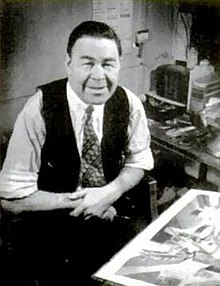| Benjamin Goodwin Seielstad | |
|---|---|
 | |
| Born | December 23, 1886 Lake Wilson, Minnesota, US |
| Died | July 1, 1960(1960-07-01) (aged 73) Inglewood, California, US |
| Nationality | American |
| Occupation(s) | Newspaper and magazine illustrator |



Benjamin Goodwin Seielstad, who worked as B. G. Seielstad, (December 23, 1886 – July 1, 1960) was an American painter and illustrator. He claimed his first job was covering the 1906 San Francisco earthquake. He worked for a variety of newspapers and for Popular Science Monthly in the 1930s before working at Life magazine in the 1940s. He was accorded a great deal of latitude in illustrating articles for Popular Science Monthly on topics such as an automated freeway, a futuristic city, and "How The World Will End".
Early life and family
Benjamin Seielstad was born in Lake Wilson, Minnesota, on December 23, 1886, to Gudbrund Julius Seielstad, a farmer, and his wife Carrie Goodwin Benson. Both had migrated to the United States from Norway. Seielstad married Nathalie Pomeroy around 1912 with whom he had a daughter, Lucile, born in Los Angeles in 1914.
He studied at the Art Students League of New York where one of his contemporaries was Jean Mannheim.
Career
Seielstad claimed his first job was covering the San Francisco Earthquake (1906). He worked as an illustrator for the Los Angeles Examiner and the Los Angeles Times, as well as for the New York Daily News, New York World and the Philadelphia Examiner.
In the 1930s he illustrated numerous articles in Popular Science Monthly for which he produced drawings showing the technical aspects of products such as a cutaway of a pocket watch (1931), as well as others showing forecast and speculative scientific developments such as a future city (1934) based on the ideas of British writer R. H. Wilenski which envisaged cities composed of buildings on slender trunks like trees. The degree of license given to Seielstad in interpreting the article text was reflected in Popular Science's comment "our artist presents here his conception of this startling proposal".
He also drew an automatic freeway (1938) and produced four illustrations for an article titled "How The World Will End" (1939), one of which showed a "giant meteor" about to hit New York City and the city's inhabitants fleeing for their lives:
-
 A hotter Sun
A hotter Sun
-
 "Giant meteor" collision with the Earth
"Giant meteor" collision with the Earth
-
 Destabilization of the Earth's crust
Destabilization of the Earth's crust
-
 Death of the Sun
Death of the Sun
By 1940, Seielstad was working for Life magazine and was pictured at work in their 1940 issue commenting that the events of the Second World War were like his first job covering the San Francisco Earthquake. He described his love of "candid-camera" work to aid him in his drawing and how he used the reader's eye like the lens of a camera, "unfolding a scene before it with his drawings".
Death
Seielstad died at Inglewood, Los Angeles, on July 1, 1960, after a long illness.
Footnotes
- ^ A meteor has been defined as "the light phenomenon produced by the passage of an object through an atmosphere that heats the surrounding gas to incandescence". As a light phenomenon, a meteor cannot collide with anything; rather, it is the moving object causing the light phenomenon, such as a meteoroid or asteroid, that may be involved in a collision. An object such as that depicted in Seielstad's image, capable of precipitating "the end of the world", would be an asteroid of substantial size.
References
- ^ "New Triumphs in Age-Old Quest for Perfect Timepiece" by John E. Lodge, Popular Science Monthly, Vol. 119, No. 6, December 1931, pp. 52–53 & 127 (p. 53)
- ^ Imagining a City of Treelike Buildings. Matt Novak, Smithsonian, 17 February 2012. Retrieved 10 July 2018
- ^ "Automated Driving in its Social, Historical and Cultural Contexts" by Fabian Kröger in Markus Maurer et al (Eds.) (2016). Autonomous Driving: Technical, Legal and Social Aspects. Springer. pp. 41–68 (p. 47). ISBN 978-3-662-48847-8.
- ^ Hughes, Edan Milton. (2002) Artists in California, 1786–1940. Vol. II: L–Z. 3rd edition. Crocker Art Museum. p. 1003.
- ^ Hughes, Stefan. (2012). Catchers of the Light: The Forgotten Lives of the Men and Women Who First Photographed the Heavens. ArtDeCiel Publishing. p. 1258. ISBN 978-1-62050-961-6.
- ^ "Life's Pictures", Life, 22 April 1940, p. 18.
- "City of Treelike Buildings Planned", Popular Science Monthly, April 1934, p. 25.
- Rubin, Alan E.; Grossman, Jeffrey N. (January 2010). "Meteorite and meteoroid: New comprehensive definitions". Meteoritics & Planetary Science. 45 (1): 114–122. Bibcode:2010M&PS...45..114R. doi:10.1111/j.1945-5100.2009.01009.x. S2CID 129972426.)
- ^ How The World Will End, According To 1939. Rose Pastore, Popular Science, 4 April 2013. Retrieved 11 July 2018.
- "How The World Will End", Popular Science Monthly, September 1939, pp. 58–59 & 222.
External links
- "Radio City to Cost $250,000,000" Popular Science Monthly, September 1930.
- https://brookstonbeerbulletin.com/beer-making-is-marvel-of-industrial-chemistry/
- https://books.google.com/books?id=QSgDAAAAMBAJ&pg=PA20